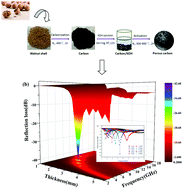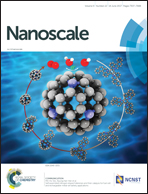Lightweight and efficient microwave absorbing materials based on walnut shell-derived nano-porous carbon
Abstract
Lightweight microwave absorbing materials have drawn tremendous attention. Herein, nano-porous biomass carbon materials have been prepared by carbonization with a subsequent potassium hydroxide activation of walnut shells and the microwave absorption properties have also been investigated. The obtained samples have large specific surface areas with numerous micropores and nanopores. The sample activated at 600 °C with a specific surface area of 736.2 m2 g−1 exhibits the most enhanced microwave absorption performance. It has the maximum reflection loss of −42.4 dB at 8.88 GHz and the effective absorption bandwidth (reflection loss below −10 dB) is 1.76 GHz (from 8.08 GHz to 9.84 GHz), corresponding to a thickness of 2 mm. Additionally, the effective absorption bandwidth can reach 2.24 GHz (from 10.48 GHz to 12.72 GHz) when the absorber thickness is 1.5 mm. Three-dimensional porous architecture, interfacial polarization relaxation loss, and the dipolar relaxation loss make a great contribution to the excellent microwave absorption performance. In contrast, the non-activated sample with lower specific surface area (435.3 m2 g−1) has poor microwave absorption performance due to a poor dielectric loss capacity. This comparison highlights the role of micropores and nanopores in improving the dielectric loss property of porous carbon materials. To sum up, porous biomass carbon has great potential to become lightweight microwave absorbers. Moreover, KOH is an efficient activation agent in the fabrication of carbonaceous materials.

- This article is part of the themed collection: 2017 Nanoscale HOT Article Collection


 Please wait while we load your content...
Please wait while we load your content...